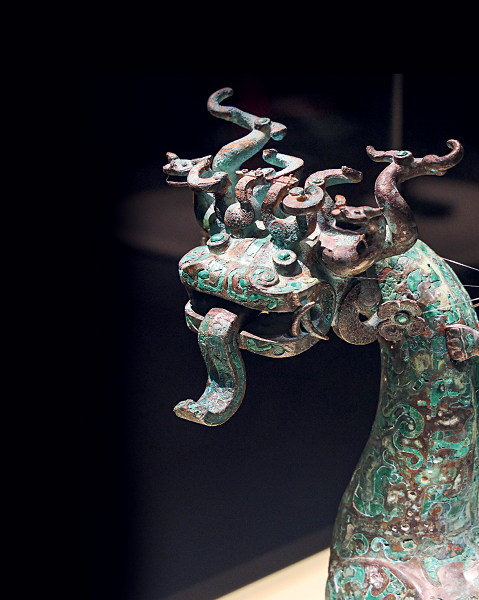
An exquisite bronze mythical beast on display at the Henan Museum in Zhengzhou, Henan Province.
The area of present-day Henan Province, located in the heart of China’s Central Plains, was considered an ideal site for a capital in ancient Chinese societies. Throughout history, more than 20 dynasties established their capital here, making it a center of political, economic, and cultural significance in the nation for over 3,000 years.
Henan Province established the Henan Museum in its regional capital Zhengzhou in 1927, to better protect and showcase its rich historical and cultural heritage. Covering a floor area of 55,000 square meters, it is one of the earliest public museums in China.
The museum houses a collection of over 170,000 artifacts, including prehistoric relics, bronzeware from the Shang (c. 1600-1046 B.C.) and Zhou (1046-256 B.C.) dynasties, ceramics, jade artifacts, and stone carvings of later regimes. Among its most iconic treasures are the Jiahu Bone Flute, Bronze Jin with Cloud Design, and Wu Zetian Gold Strip.
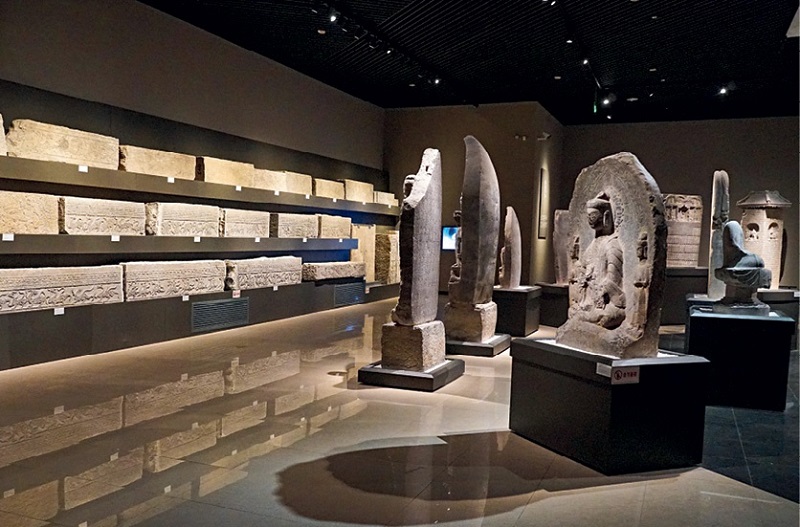
The gallery of the Ancient Stone Carving Art in the Central Plain exhibition at the Henan Museum.
Jiahu Bone Flute
Crafted over 8,000 years ago, the Jiahu Bone Flute was unearthed from the Jiahu Neolithic site in Wuyang, central Henan, in 1987. It is the earliest and most well-preserved wind instrument discovered in China to date. Known as “the first flute of China,” it marks a key milestone in the history of Chinese music.
The flute is made from a hollow wing bone of a crane, with multiple finger holes drilled with remarkable precision. This instrument produces a tone that is pure and ethereal. Judging by the equidistant markers on the flute, as well as the pitches it can produce, its length, diameter, and hole placement were carefully calculated by its creator.
The most surprising fact about this ancient instrument is that it can play an almost complete seven-pitch scale. This finding challenges the long-standing notion that the seven-note scale originated in the West, by showing that as early as 8,000 years ago, ancient Chinese had already possessed an advanced understanding of musical theory.
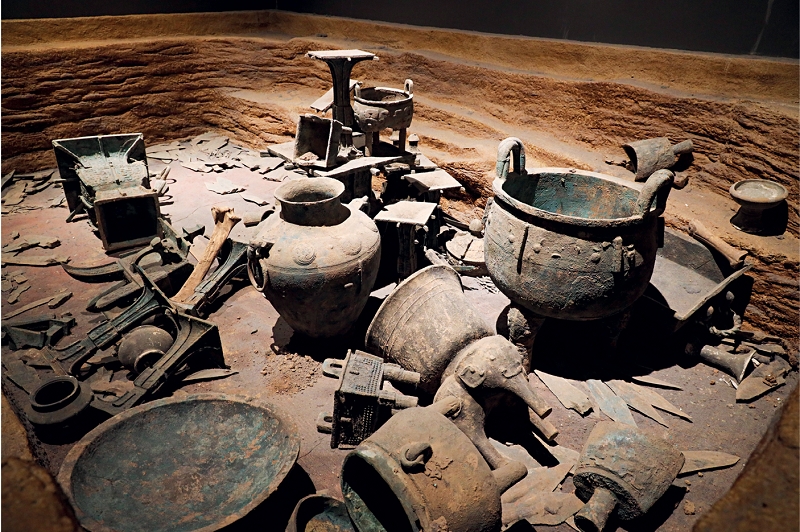
A replica of the archaeological site of the No.160 tomb at Guojiazhuang, Anyang, at the Henan Museum.
Bronze Jin with Cloud Design
Bronze Jin is a wine vessel stand used by the nobility at banquets or on sacrificial occasions during the Zhou Dynasty. The Bronze Jin with Cloud Design, dating to the Spring and Autumn period (770-476 B.C.), is a star relic in the Henan Museum. Its main body features intricate cloud designs in openwork, supported by 12 tiger-shaped beasts serving as table legs and decorated with 12 dragon-shaped beasts around its top that look like they are poised to take a sip of the wine.
This 95-kilogram Jin was cast with the lost-wax technique, a casting method for producing more complex patterns compared with clay molding. This technique was one of the three major casting methods used in ancient China. The discovery of this stunning bronze relic proves that lost-wax casting had reached an advanced level in China by the mid–Spring and Autumn period.
When the Jin was found during excavations in 1978, it was severely damaged. With no prior restoration cases of its kind to reference, experts at the Henan Museum undertook a meticulous restoration process involving 26 procedures, which took over nearly three years to complete, to restore the Jin to its former glory.
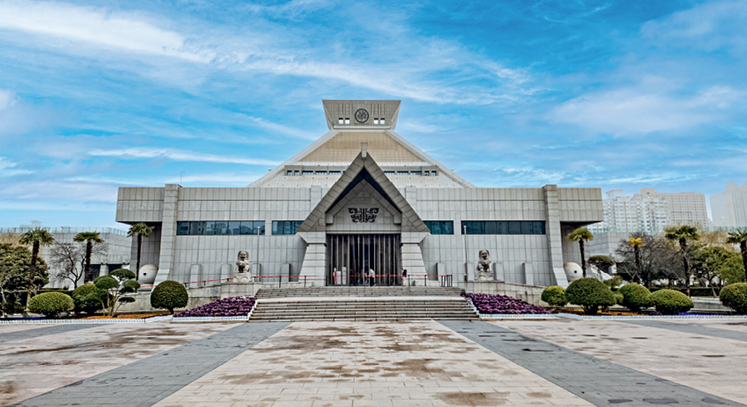
The façade of the Henan Museum.
Wu Zetian Gold Strip
In May 1982, a farmer in Dengfeng County, Henan, discovered a gold strip lodged in a crevice on the Songshan Mountains, which has been revered as one of the Five Sacred Mountains in China from antiquity. Identified as an item of Wu Zetian, it provides insights into the final years of China’s only female monarch.
This Tang Dynasty (618-907) relic measures 36.2 centimeters in length, 8 centimeters in width, and weighs 223.5 grams. The inscription on it of 63 characters states that the empress devoutly followed Taoism and longed for immortality. She dispatched an envoy named Hu Chao on behalf of her to the Songshan Mountains to deliver the gold strip and pray to the Taoist deities for her health. The date inscribed is the seventh day of the seventh month in the traditional Chinese calendar of 700 AD.
As the only female ruler in Chinese history, Wu ruled for over four decades. Despite her historical significance, few artifacts directly linked to her have been found to date, apart from some stone tablets. This is because most remain buried in the Qianling Mausoleum, which has yet to be excavated for preservation reasons. Thus, this gold strip remains the only known movable artifact associated with her, offering valuable insights into her life, particularly her later years.
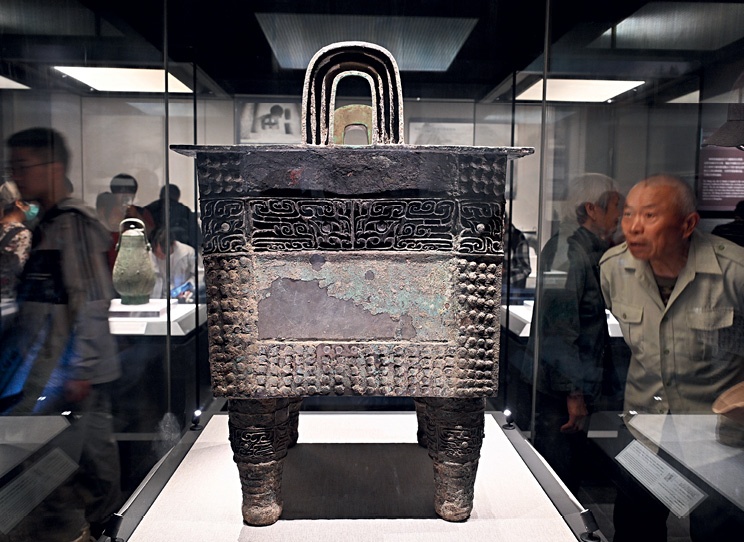
A visitor is admiring the Bronze Rectangular Ding Cauldron with Animal Mask Motif.
Huaxia Ancient Music Orchestra
A number of musical instruments from various historical periods have been discovered in Henan. They not only have unique forms but also display tonal ranges and pitches comparable to modern music. To help modern audiences appreciate ancient Chinese music, the Henan Museum established the Huaxia Ancient Music Orchestra in 2000.
This professional performing troupe is dedicated to reenacting the musical traditions of China from prehistory to the Ming and Qing dynasties (1368-1911), with a focus on recreating traditional music instruments by drawing on findings of archaeological research. It has produced ancient instruments such as chime bells, a phoenix drum, and a bone flute.
Since its debut on April 1, 2000, the Huaxia Ancient Music Orchestra has become a major attraction at the museum. Performing twice daily in the concert hall, it delivers over 600 shows each year. Its performances are so popular that they often sell out fast during weekends and holidays.
In the concert hall, the museum employs digital technologies such as holographic projections and LED multimedia to present a multidimensional display of cultural relics, as well as archaeological findings. Through these technological means, audiences not only enjoy the music but also immerse themselves in historical scenes of various periods.
The museum has also created an online concert hall on its official website, providing information about ancient Chinese music and videos of the performance of the Huaxia Ancient Music Orchestra, to reach audiences around the world.
In addition, the orchestra leverages digital filming, production, and new media platforms to disseminate its research and reconstruction performances. This has led to the creation of a “Cloud Concert Hall,” enabling the ancient music to reach wider audiences around the world through a new voice.